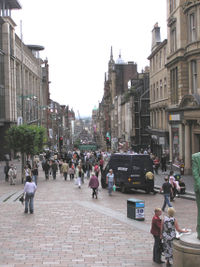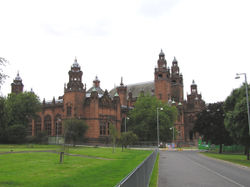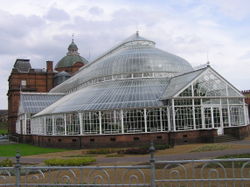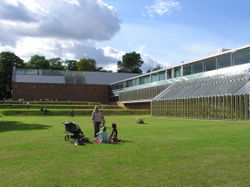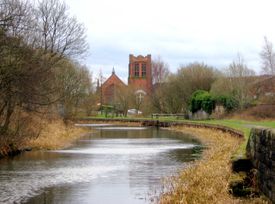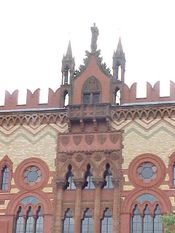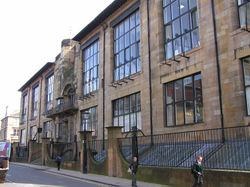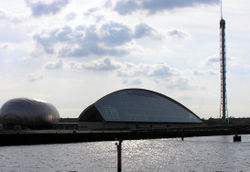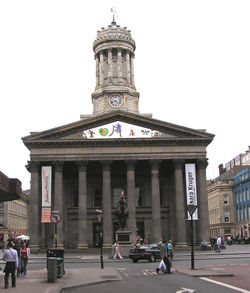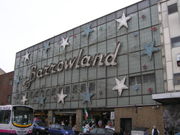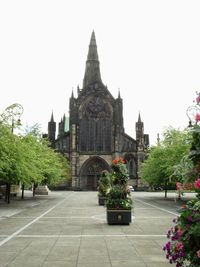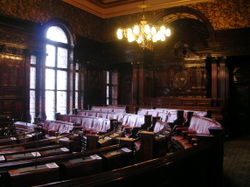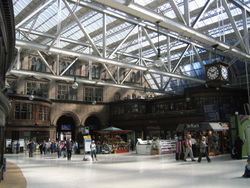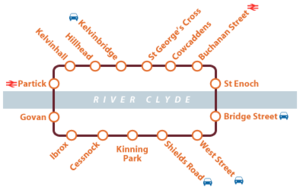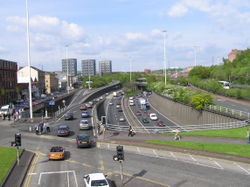Glasgow
2007 Schools Wikipedia Selection. Related subjects: Geography of Great Britain
| Glasgow | |
|---|---|
| Gaelic: | Glaschu |
| Scots: | Glesca, Glesgae |
| Location | |
| OS grid reference: | NS590655 |
| Statistics | |
| Population: | 585,090 |
| Metropolitan Population: | 1,749,154 |
| Administration | |
| Council area: | Glasgow City |
| Constituent country: | Scotland |
| Sovereign state: | United Kingdom |
| Other | |
| Police force: | Strathclyde Police |
| Lieutenancy area: | Glasgow |
| Former county: | Lanarkshire |
| Post office and telephone | |
| Post town: | GLASGOW |
| Postal district: | G1-G81 |
| Dialling code: | 0141 |
| Politics | |
| UK Parliament: | Glasgow Central Glasgow East Glasgow North Glasgow North East Glasgow North West Glasgow South Glasgow South West |
| Scottish Parliament: | Glasgow region: Glasgow Anniesland Glasgow Baillieston Glasgow Cathcart Glasgow Govan Glasgow Kelvin Glasgow Maryhill Glasgow Pollok Glasgow Rutherglen Glasgow Shettleston Glasgow Springburn |
| European Parliament: | Scotland |
Glasgow (Glaschu in Gaelic; or Glesca/Glesga in Scots) is the largest city in Scotland. The City of Glasgow is also the most populous unitary authority area. It is situated on the River Clyde in the country's west central lowlands. People from Glasgow are known as Glaswegians. Glaswegian is also the name of the local dialect of Scots, which is popularly referred to as "the Glasgow Patter".
The city was formerly a royal burgh, and was known as the " Second City of the British Empire" in the Victorian era. It established itself as a major transatlantic trading port during the Industrial Revolution. The Clyde was the world's pre-eminent shipbuilding centre, building many revolutionary and famous vessels such as the Cunard liners RMS Lusitania, RMS Aquitania, RMS Queen Mary, RMS Queen Elizabeth, RMS Queen Elizabeth 2, and the Royal Yacht Britannia.
The city grew in the late 19th and early 20th centuries to a population of over one million people, peaking at 1,088,000 in 1931. However, with population decline, due to both the large scale relocation of people to new towns like East Kilbride and Cumbernauld on the outskirts of the city, and successive boundary changes by the Scottish Office and UK governments, the current population of the City of Glasgow itself is 585,090 and 1,168,270 in the urban areas surrounding the city, based on the 2001 census. Around 2,300,000 people live in the Greater Glasgow conurbation, defined as the City of Glasgow and the surrounding region.
Glasgow is the third most popular foreign tourist destination in the UK after London and Edinburgh. The city also has Scotland's largest and most economically important commerce and retail sector. Glasgow is also one of Europe's top 16 financial centres and is home to many of the country's leading businesses.
Etymology
It is common to derive the name Glasgow from the older Brythonic glas cau or a Middle Gaelic cognate, which would have meant green hollow. The settlement probably had an earlier Cumbric name, Cathures; the modern name appears for the first time in the Gaelic period (1116), as Glasgu. However, it is also recorded that the King of Strathclyde, Rhydderch Hael, welcomed Saint Mungo (also known as Saint Kentigern), and procured his consecration as bishop, which took place about 540. For some thirteen years Kentigern laboured in the region, building his church at the Molendinar Burn, and making many converts. A large community developed around him and became known as Glasgu (meaning the dear family). The confusion between the terms is not wholly resolved (Dear Family vs. Dear Green Place vs. Green Hollow).
Dear Green Place (Glaschu) is often misquoted as a Gaelic translation for the city, but this was actually Daniel Defoe's description of the city when he visited in the early 18th century; he also claimed that Glasgow was "the paradise of Scotland and one of the cleanliest and best built cities in Britain." Another writer of the time said of the River Clyde: "I have never seen before any river which for natural beauty can stand competition with the Clyde. Never did a stream glide more gracefully to the ocean or through a fairer region." At that time, the city's population numbered approximately 12,000, and its structures largely consisted of compact wooden buildings, none of which remain today.
Heraldry
Glasgow's Coat of Arms dates back to 1866 when the Lord Lyon first granted the city its patent. The Coat of Arms commemorates Glasgow's patron saint, Mungo, and includes four emblems — a bird, a tree, a bell, and a salmon with a ring in its mouth. The emblems represent miracles supposed to have been performed by Mungo and are listed in the following traditional rhyme:
-
-
-
- Here's the bird that never flew
- Here's the tree that never grew
- Here's the bell that never rang
- Here's the fish that never swam
- Here's the tree that never grew
- Here's the bird that never flew
-
-
The supporters are two salmon bearing rings, and the shield bearing the four motifs is surmounted by a castle (or sometimes a helm) above which is St Mungo himself.
The motto of the city, taken from a sermon preached by Mungo, is Let Glasgow Flourish, a shortened version of Lord, Let Glasgow flourish by the preaching of the word and the praising of thy name. The motto was more recently commemorated in a song called "Mother Glasgow", written by Dundonian songwriter Michael Marra, and popularised by Hue and Cry.
Geography and climate
Glasgow is located on the banks of the River Clyde, in West Central Scotland.
Climate
Glasgow weather is typical of Scottish weather and often unpredictable.
The summer months (May to September) are often mild but unpredictable. The winds are generally westerly, due to the warm Gulf Stream. The warmest month is usually July, averaging 19°C (66.2°F). However, temperature can change suddenly, and is normally a few degrees colder than southern England. Mornings may be damp and misty, or dreich (a Scottish term for damp and drizzly), but become sunny and warm by afternoon.
Though there are some rainy and windy days, spring (March to May) is fairly mild. Many of Glasgow's trees begin to flower at this time of the year and the parks and gardens are filled with spring colour.
Winters can be damp with few sunny days; however the Gulf Stream ensures that Glasgow stays warmer than other cities at the same latitude. Winds can be chilling and cold, though severe snowfalls are infrequent and do not last. December, January and February are the wettest months of the year, but can occasionally be sunny and clear.
Temperature
| Jan | Feb | Mar | Apr | May | Jun | Jul | Aug | Sep | Oct | Nov | Dec | |||
|---|---|---|---|---|---|---|---|---|---|---|---|---|---|---|
| Average maximum daily temperature ( °C) | 6 | 7 | 8 | 11 | 15 | 17 | 19 | 18 | 16 | 12 | 9 | 7 | ||
| Average minimum daily temperature ( °C) | 1 | 1 | 2 | 3 | 6 | 9 | 11 | 11 | 8 | 6 | 3 | 2 | ||
| Mean daily temperature ( °C) | 4 | 4 | 6 | 7 | 11 | 13 | 15 | 14 | 12 | 9 | 6 | 4 | ||
| Average maximum daily temperature ( °F) | 43 | 45 | 46 | 52 | 59 | 63 | 66 | 64 | 61 | 54 | 48 | 45 | ||
| Average minimum daily temperature ( °F) | 34 | 34 | 36 | 37 | 43 | 48 | 52 | 52 | 46 | 43 | 37 | 36 | ||
| Mean daily temperature ( °F) | 39 | 39 | 43 | 45 | 45 | 55 | 55 | 57 | 54 | 48 | 43 | 39 | ||
| Source: Source: | ||||||||||||||
Demographics
The actual city council area of Glasgow peaked in population the 1930s with a population of 1,088,000 people and for over 50 years was over 1.3 million people. However, after the peak of the 1930s the population declined, due to relocation to the 'new towns' in clearings of the poverty-stricken inner city areas like the Gorbals. Glasgow was during this period of its history one of the most densely populated cities in the world. In addition, successive boundary changes reduced the official city boundaries (and hence official population) making direct comparisons difficult as the city continues to expand beyond the official city council boundaries into surrounding suburban areas, emcompassing nearly 400 square miles if all adjoining suburbs, commuter towns and villages are included.
There are two distinct definitions for the population of Glasgow; the Glasgow City Council Area (which lost the district of Rutherglen to South Lanarkshire and the Greater Glasgow Urban Area which includes the urban cornubation around the city.
| Location | Population | Area (km²) |
Density (/km²) |
|---|---|---|---|
| Glasgow City Council | 585,090 | 175.49 | 33.34 |
| Greater Glasgow Urban Area | 1,168,270 | 368.47 | 37.70 |
Source
Since the 2001 census the population decline has stabilised and the population of both the City of Glasgow council area and Greater Glasgow are forecast to grow in the near future (the 2004 population of the City of Glasgow council area was 585,090). However when all suburbs and other towns forming the conurbation in the Glasgow area are included the population almost doubles in number.
Compared to Inner London (22,438 people per sq mile), Scotland's major city has less than half the current population density of the English capital (8,528). However, in 1931 the population density was 16,011, highlighting the 'clearances' of the inner city to the suburbs and new towns that were built to empty one of Europe's most densely populated cities.
History
The area of Glasgow has long been used for settlement due to the River Clyde providing a natural area for fishing. Glasgow became important in the 12th century as the site of a bishopric, reorganized by King David I of Scotland and John, Bishop of Glasgow. There had been an earlier religious site the exact age of which is unknown. According to doubtful hagiographical tradition, this ecclesiatical site had been established by Saint Kentigern. The bishopric became one of the largest and wealthiest in the Kingdom of Scotland, bringing wealth and status to the town. Somewhere between 1175 and 1178 this position was strengthened even further when Bishop Jocelin obtained for the episcopal settlement the status of burgh from King William the Lion, allowing the settlement to expand with the benefits of trading monopolies and other legal guarantees. Sometime between 1189 and 1195 this status was supplemented by an annual fair, which survives to this day as the Glasgow Fair.
Glasgow grew over the following centuries, and the founding of the University of Glasgow in 1451 and elevation of the bishopric to an archbishopric in 1492 increasing the town's religious and educational status. In the 16th century Glasgow became prominent in international trading as a hub of trade to the Americas, especially in the movement of tobacco, cotton and sugar. The industries of Scotland produced textiles, coal and steel, which were exported. Shipbuilding became a major industry on the Clyde, building many famous ships. By the end of the 19th century the city was known as the "Second City of the Empire" and was producing most of the ships and locomotives in the world. During this period, the construction of many of the city's greatest architectural masterpieces and most ambitious civic projects were being funded by its wealth.
The 20th century showed a great decline in the city's fortunes, especially with the effects of two World Wars and the Great Depression. The city's industries became uncompetitive, leading to high unemployment, urban decay and poor health for the city's inhabitants. At the end of the Second World War there were active attempts at regeneration of the city, when the Glasgow Corporation published its Bruce Report which set out a comprehensive series of initiatives aimed at turning round the decline of the city.
By the end of the century there had been a significant resurgence in Glasgow's economic fortunes, finding a new role as a European centre for business and finance, as well an increase in tourism. The latter due to the legacy of the city's status as European City of Culture in 1990, and the product of its thriving artistic community. The ongoing regeneration of inner-city areas has led to people moving back to live in the centre of Glasgow, although some areas of the city remain amongst the most deprived in the UK.
Districts
Glasgow was historically based around Glasgow Cathedral, the old High Street and down to the River Clyde via Glasgow Cross.
City centre
The city centre is bounded by the High Street to the east, the River Clyde to the south and the M8 motorway to the west and north which was built through the Charing Cross and Anderston areas in the 1960s.
Retail and theatre district
The City Centre is based on a grid system of streets, similar to that of Barcelona or an American city, on the north bank of the River Clyde. The heart of the city is George Square, site of many of Glasgow's public statues and the elaborate Victorian Glasgow City Chambers, headquarters of Glasgow City Council. To the south and west are the shopping precincts of Argyle, Sauchiehall and Buchanan Streets. The main shopping malls are Buchanan Galleries and the St Enoch Centre, as well as the more specialised, designer malls; Princes' Square and the Italian Centre. The London-based department stores, Selfridges and Harvey Nichols are planning to open in the city, further strengthening Glasgow's already impressive retail portfolio, which forms the UK's largest and most economically important commerce and retail sector after London's West End. The layout of the approximately two and a half mile long retail district of Buchanan Street, Sauchiehall Street and Argyle Street has been termed the "Golden Z". In October 2005 retail locations in the area were sought after to the extent that Buchanan Street had the 7th highest shop rental fees in the world.
The city centre is home to most of Glasgow's main cultural venues: The Theatre Royal (home of Scottish Opera and Scottish Ballet), The Pavilion, The King's Theatre, Glasgow Royal Concert Hall, Glasgow Film Theatre, RSAMD, GoMA, Mitchell Library, the Centre for Contemporary Arts, McLellan Galleries and The Lighthouse Museum of Architecture, Design and the City. The world's tallest cinema, the 18 screen Cineworld is sited on Renfrew Street. The city centre is also home to two of Glasgow's three universities: Strathclyde and Glasgow Caledonian University.
Merchant City
To the east is the commercial and residential district of Merchant City, which was formerly the residential district of the wealthy City Merchants in the 18th and early 19th centuries. As the Industrial Revolution and the wealth it brought to the city resulted in the expansion of Glasgow's central area westward, the original medieval centre was left behind. This area, commonly known as "Old Glasgow" takes in the eastern fringes of the Merchant City and some of the East End. Glasgow Cross, situated at the junction of High Street, Gallowgate, Trongate and Saltmarket was the original centre of the city. In the Cross sits the Tolbooth clock tower; all that remains of the original City Chambers, which was destroyed by fire in 1926. Moving northward up High Street towards Rottenrow and Townhead lies the 15th Century Glasgow Cathedral and the Provand's Lordship. Latterly, due to growing industrial pollution levels in the mid to late 19th century, the area fell out of favour with residents, who mostly moved to the newly developed West End and South Side districts.
From the late 1980s onwards, the area has been rejuvenated with luxury city centre apartments and warehouse conversions. Many new cafes and restaurants have opened. The area also contains the old Tolbooth, The Tron Theatre, The Old Fruitmarket, The Trades Hall, and the City Halls.
The area is also home to Glasgow's growing 'Arts Quarter', based around the Saltmarket and Trongate, and at the heart of the annual Merchant City Festival.
A large part of Glasgow's gay scene is located within the Merchant City area. This includes Polo Lounge, MODA, Delmonicas and Clone Zone.
Recently the city council defined (and perhaps expanded) the area known as Merchant City as far West as Buchanan Street, marking these boundaries with new, highly stylised metal signage.
Financial district
To the western edge of the city centre, occupying the areas of Blythswood Hill and Anderston, and along the Broomielaw, lies Glasgow's financial district, known as the "square kilometre" or more officially the International Financial Services District (IFSD). Since the late 1980's the ISFD has grown to become the third largest financial centre in the UK after the The City of London and Edinburgh. With a reputation as an established financial services centre, coupled with comprehensive support services, Glasgow continues to attract and grow new business. Of the 10 largest general insurance companies in the UK, 8 have a base or Head office in Glasgow - including Direct Line, AXA and Norwich Union. Key banking sector companies have also relocated to commercial property in Glasgow - Abbey, HBOS, National Australia Bank and the Royal Bank of Scotland.
Since the late 1980s, this area of the city centre has seen the construction of many ultra-modern office blocks, a trend which continues into the 21st century with a new wave of high rise developments currently on the drawing board.
The West End
Glasgow's West End refers to the bohemian district of cafés, bars, boutique's, upmarket hotels, clubs and restaurants in the hinterland of Kelvingrove Park. The west End's main thouroughfare is Byres Road and one of the star attractions is known as Ashton Lane. The west end has many diferent districts within it like, the University of Glasgow, BBC Scotland's Headquarters, Glasgow Botanic Gardens and the Scottish Exhibition and Conference Centre. The district is home to some of the wealthiest addresses in the country. The West End includes the upmarket residential areas of Hillhead, Dowanhill, Kelvingrove, Kelvinside, Hyndland and Jordanhill, the commercial and social area around Byres Rd and, to a lesser extent, Partick (a more working class area). However the name is now being used to mean anywhere to the west of Charing Cross. This includes areas like Kelvinbridge, Kelvindale and Anniesland. The spire of Sir George Gilbert Scott's Glasgow University main building (the second largest Gothic Revival building in Britain) is a major local landmark, and can be seen for miles around, sitting atop Gilmorehill. The University itself is the fourth oldest in the English-speaking world, after Oxford, Cambridge and St. Andrews. Much of the city's student population is based in the West End, adding to its cultural vibrancy.
The area is also home to the Kelvingrove Art Gallery and Museum, Hunterian Museum, Kelvin Hall International Sports Arena, Henry Wood Hall (home of the Royal Scottish National Orchestra) and the Museum of Transport, which is to be rebuilt on an old dockland site at Glasgow Harbour to a design by Zaha Hadid. The West End Festival, one of Glasgow's biggest festivals, is held annually in June.
Glasgow is Europe's fastest growing conference and events destination, and the SECC is the UK's largest exhibition and conference centre. A major expansion of the SECC facilities at the former Queens Dock by Foster and Partners is currently planned, including a 12,000 seat arena, and a 5 star hotel and entertainments complex.
The area is served by bus, rail and the Glasgow Subway.
The East End
The East End is home to the famous Glasgow Barrowland market, popularly known as 'The Barras', and Barrowland Ballroom music hall, Glasgow Green, and Celtic Park, home of Celtic Football Club. Many of the original sandstone tenements remain in this district. The East End in contrast to the West end, includes some of the most deprived areas in the UK. However, many areas of the district are not deprived in any way.
The Glasgow Necropolis cemetery was created on a hill above the cathedral of St Mungo in 1831. Routes curve through the landscape uphill to the 62 metre high statue of John Knox at the summit, with some tombs designed by prominent local architect Alexander 'Greek' Thomson. The design creates a dramatic skyline of obelisks, pinnacles and statues in memory of Glasgow's wealthiest inhabitants. It was described by James Curle as 'literally a city of the dead'. The main entrance is approached by a bridge over what was the Molendinar Burn towards an impressive set of classical mausolea. The bridge, designed by James Hamilton, is known as the Bridge of Sighs because it formed the route of funeral processions.
There are two late 18th century tenements in Gallowgate. Dating from 1771 and 1780, both have been well restored. The construction of Charlotte Street was financed by David Dale, whose former pretensions can be gauged by the one remaining house, now run by the National Trust for Scotland. Further along Charlotte Street there stands a modern GKC building of some note. Once a school, it has been converted into flats. Surrounding these buildings are a series of innovative housing developments conceived as 'Homes for the Future', part of a project during the city's year as UK City of Architecture and Design in 1999.
East of Glasgow Cross is the magnificent St Andrews Church, built in 1746 and displaying a Presbyterian grandeur befitting the church of the city's wealthy Tobacco merchants. Also close by is the more modest Episcopalian St Andrews-by-the-Green, the oldest post-Reformation church in Scotland.
Overlooking Glasgow Green is the façade of Templeton's carpet factory, featuring vibrant polychromatic brickwork intended to evoke the Doge's Palace in Venice.
The extensive Tollcross Park was originally developed from the estate of James Dunlop, the owner of a local Steelworks. His large baronial mansion was built in 1848 by David Bryce, which later housed the city's Children's Museum until the 1980s. Today, the mansion is a sheltered housing complex.
The new Scottish National Indoor Sports Arena, a modern replacement for the Kelvin Hall, is planned for Dalmarnock. If the 2014 Commonwealth Games bid is successful, the area will house the Athletes' Village, adjacent to the new indoor sports arena.
To the north of the East End lie the two massive gasometers of Provan Gas Works, which stand overlooking Alexandra Park and a major interchange between the M8 and M80 motorways. Often used for displaying large city advertising slogans, the towers have become an unofficial portal into the city for road users arriving from the North and East.
The South Side
Glasgow's South Side, the largest area of the city, sprawls out south of the Clyde, and outwith the local council's jurisdiction, covering areas including The Gorbals, Shawlands, Strathbungo, Mount Florida, Pollokshaws, Nitshill, Pollokshields, Queens Park, Ibrox, Cessnock, Govan, Mansewood, Arden, Darnley, Pollok, Priesthill, Cathcart, Busby, Clarkston, Giffnock, Thornliebank and Newton Mearns.
Although predominantly residential, the area does have several notable public buildings. Charles Rennie Mackintosh's Scotland Street School Museum and House for an Art Lover, the world famous Burrell Collection in Pollok Country Park, the National Football Stadium Hampden Park in Mount Florida and Ibrox Stadium, home of Rangers. The former docklands site at Pacific Quay on the south bank of the River Clyde, opposite the SECC, is the site of the Glasgow Science Centre and the new headquarters for BBC Scotland and SMG plc (owner of stv) which are relocating there to a new purpose built digital media campus.
In addition, several new bridges spanning the River Clyde have been built or are currently planned, including The Clyde Arc at Pacific Quay and others at Tradeston and Springfield Quay.
The South Side also includes many great parks, including Linn Park, Queens Park, Bellahouston Park and Rouken Glen Park, and several golf clubs, including the championship course at Haggs Castle. The South Side is also home to Pollok Country Park, which is Glasgow’s largest park and the only Country Park within the city boundaries.
Govan is a district and former burgh in the south-western part of the city. It is situated on the south bank of the River Clyde, opposite Partick. It was an administratively independent Police Burgh from 1864 until it was incorporated into the expanding city of Glasgow in 1912.
Govan has a great legacy as an engineering and shipbuilding centre of international repute and is home to one of two BAE Systems shipyards on the River Clyde and the precision engineering firm, Thales Optronics. It is also home to the Southern General Hospital, one of the largest teaching hospitals in the country, and the maintenance depot for the Glasgow Subway system.
North Glasgow
North Glasgow extends out from the north of the City Centre towards the affluent suburbs of Bearsden, Milngavie, Bishopbriggs and Lenzie in East Dunbartonshire. However, it also contains some of the city's poorest residential areas. Possilpark is one such area, where levels of unemployment and drug abuse continue to be above the national average. Much of the housing in areas such as Possilpark and Hamiltonhill had fallen into a state of disrepair in recent years. This has led to large scale redevelopment of much of the poorer housing stock in North Glasgow, and the wider regeneration of many areas, such as Ruchill, which have been transformed; many run-down tenements have now been refurbished or replaced by modern Housing estates.
Much of the housing stock in North Glasgow is rented social housing, managed by the Glasgow Housing Association. In parts of the North of the city, such as Springburn, there are many high-rise tower blocks. These buildings were constructed in the 1960s and 1970s and were viewed as the answer to Glasgow’s inner-city slum problems, but are now widely discredited as being poorly built and unsuited to traditional urban living, and are held responsible by many for the social alienation that exists in the poorest parts of the city today.
Not all areas of North Glasgow are of this nature however. Maryhill for example consists of well maintained traditional sandstone tenements. Although historically a working class area, its borders with the upmarket West End of the city mean that it is relatively wealthy compared to the rest of the North of the city, containing affluent areas such as Maryhill Park and North Kelvinside. Maryhill is also home to Firhill Stadium, home of Partick Thistle since 1909, and since 2005, the professional Rugby Union team, Glasgow Warriors. The junior team, Maryhill F.C. are also located in this part of North Glasgow.
The Forth and Clyde Canal passes through this part of the city, and at one stage formed a vital part of the local economy. It was for many years polluted and largely unused after the decline of heavy industry, but recent efforts to regenerate and re-open the canal to navigation have seen it rejuvenated.
Sighthill is home to Scotland’s largest asylum seeker community, and despite some initial racial tensions between all the different racial and religious groups involved, there has been widespread praise about how this diverse new community has been able to integrate successfully.
A huge part of the economic life of Glasgow was once located in Springburn, where the engineering works and locomotive workshops employed many Glaswegians. Indeed, Glasgow dominated the manufacturing of locomotives, with 25% of all the world’s trains being built in the area at one stage. It was home to the headquarters of the North British Locomotive Company. Today the engineering group Alstom's railway maintenance facility in the area is all that is left of the industry in Springburn.
Architecture
Very little of medieval Glasgow remains, the two main landmarks from this period being the 14th century Provand's Lordship and Glasgow Cathedral. The vast majority of the city as seen today dates from the 19th century. As a result, Glasgow has an impressive heritage of Victorian architecture - the Glasgow City Chambers, the main building of the University of Glasgow, designed by Sir George Gilbert Scott, and the Glasgow School of Art, designed by Charles Rennie Mackintosh, being outstanding examples. Another architect who had a great and enduring impact on the city's appearance was Alexander Thomson, who produced a distinctive architecture based on fundamentalist classicism that gave him the nickname "Greek". He was described as a "quiet, stay-at-home Victorian behind whose buttoned-up facade there seethed a kind of stylistic corsair who plundered the past for the greater glory of the present".
The buildings reflect the wealth and self confidence of the residents of the "Second City of the Empire". Glasgow generated immense wealth from trade and the industries that developed from the Industrial Revolution. The shipyards, marine engineering, steel making, and heavy industry all contributed to the growth of the city. At one time the expression "Clydebuilt" was synonymous with quality and engineering excellence. The Templeton's Carpet Factory on Glasgow Green was designed to resemble the Doge's Palace in Venice. The allusions to another great trading city, seem appropriate.
Many of the city's most impressive buildings were built with red or blond sandstone, but during the industrial era those colours disappeared under a pervasive black layer of soot and pollutants from the furnaces.
Tenements were built to house the workers who had migrated from Ireland and the Scottish Highlands in order to feed the local demand for labour; these tenements were often overcrowded and unsanitary, and many developed into the infamous Glasgow slums, the Gorbals area being one of the most notorious.
In recent years many of these buildings have been cleaned and restored to their original appearance. Others were demolished to make way for large, barrack-like housing estates, and high-rise flats in tower blocks. The latter were built in large numbers during the 1960s and early 1970s; Glasgow has a higher concentration of high-rise buildings than any other city in the British Isles. At 31 storeys, the Red Road flats in the north of the city were for many years the highest residential buildings in Europe. These housing estates, known as "schemes", are widely regarded as unsuccessful: many, such as Castlemilk, were just dormitories well away from the centre of the city with no amenities ("deserts wi' windaes" [deserts with windows], as Billy Connolly put it), and their establishment led to the split up of long established community relationships. Some of the high-rise developments were poorly designed and cheaply built and became magnets for crime. Over time some have become as bad as the slum areas that they replaced, though at the time of construction they were largely welcomed. On 7 March 2003, the Glasgow Housing Association took ownership of the housing stock from the city council, and has begun a programme of demolishing the worst of the tower blocks.
Modern buildings in Glasgow include the Glasgow Royal Concert Hall, and along the banks of the Clyde are the Glasgow Science Centre and the Scottish Exhibition and Conference Centre, whose Clyde Auditorium was designed by Sir Norman Foster, and is affectionately known as the "Armadillo". Zaha Hadid has won a competition to design the new Museum of Transport, which will move to the waterfront. Shopping centres include the Buchanan Galleries, the glass pyramid of the St Enoch Centre, and the upmarket Princes Square.
Given the history of high rises in Glasgow, the council's policy of allowing new tall buildings has attracted some controversy. The 39-storey Elphinstone Place mixed-use skyscraper in Charing Cross, will be the tallest building in Scotland, and is scheduled to begin construction in mid 2006. Much development is taking place along the banks of the Clyde. Glasgow Harbour, which neighbours Partick is one of the largest residential developments. The second phase was unfavourably compared to the Red Road flats, but was granted planning permission.
Culture
The city has many amenities for a wide range of cultural activities, from curling to opera and from football to art appreciation; it also has a large selection of museums that include those devoted to transport, religion, and modern art. The city's principal library, the Mitchell Library, is the largest public reference library in Europe, currently housing some 1,213,000 volumes.
Theatres, museums and galleries
Glasgow is home to a variety of theatres including The Kings Theatre, Theatre Royal and the Citizens Theatre and is home to many municipal museums and art galleries, the most famous being the Kelvingrove Art Gallery and Museum, the GoMA and the Burrell Collection.
Festivals and exhibitions
The city has hosted many exhibitions over the years, including being the UK City of Achitecture 1999, European Capital of Culture 1990, National City of Sport 1995-1999 and European Capital of Sport 2003.
In addition, unlike the Edinburgh Festival (where all Edinburgh's main festivals occur in the last three weeks of August), Glasgow's festivals virtually fill the entire calendar, from January through to December. Major festivals include the Glasgow Comedy Festival, Glasgow Jazz Festival, Celtic Connections, Glasgow Film Festival, West End Festival, Merchant City Festival, Glasgay, and the World Pipe Band Championships.
Music scene
Glasgow has many live music pubs, clubs and venues.
Some of the city's main venues include the Glasgow Royal Concert Hall, the SECC and King Tut's Wah Wah Hut (where Oasis were spotted and signed by Glaswegian record mogul Alan McGee) and The Barrowlands, a historic ballroom, converted into a mecca of live music. The newest venue in the city is the ABC which, since opening in 2005, has featured bands such as The Fratellis and The Raconteurs. In the more alternative scene, the Cathouse often hosts gigs from a variety of Punk, Metal and Industrial bands. Glasgow is also home to a thriving electronic music scene, with a particularly strong reputation for techno and house music. Clubs like The Arches, The Sub Club and record labels such as Soma and Glasgow Underground have supported this strong underground movement for the past two decades in the city.
Sport
Glasgow has a long sporting history, with the world's first international football match held in 1872 at the West of Scotland Cricket Club's Hamilton Crescent ground in the Partick area of Glasgow. The match was between Scotland and England and resulted in a 0–0 draw. It is the only city to have had two football teams competing in European finals in the same season: in 1967 Celtic were in the 1967 European Cup final while at the same time Rangers were in the Cup Winners Cup final.
Football
The city is home to Scotland's largest football stadia: Celtic Park (60,832 seats), Ibrox Stadium (51,082 seats) and Hampden Park (52,670 seats), which is Scotland's national football stadium. Hampden Park holds the European record for attendance at a football match: 149,547 saw Scotland beat England 3-1 in 1937, in the days before British stadiums became all-seated.
Glasgow has three professional football clubs: Celtic and Rangers, which together make the Old Firm, and Partick Thistle. A fourth club, Queen's Park, is an amateur club that plays in the Scottish professional league system. It had two other professional clubs in the late 20th century: Clyde, which moved to Cumbernauld, and Third Lanark, which went bankrupt. There are a number of Scottish Junior Football Association clubs within the city as well, such as Pollok, Maryhill and Petershill, as well as countless numbers of amateur teams.
The history of football in the city, as well as the status of the Old Firm, attracts many visitors to football matches in the city throughout the season. It is the only city in Europe with three stadia each with a capacity of at least 50,000 seats. Hampden Park and Ibrox have also been awarded UEFA 5 star status, meaning that they are capable of hosting the final of the Champions League. Celtic Park however does not, owing to the changing rooms in the listed South Stand being too small. Hampden has hosted the final on three occasions, most recently in 2002. Hampden will also host the UEFA Cup final in 2007. The Scottish Football Association, the national governing body, and the Scottish Football Museum are based in Glasgow, as are the Scottish Football League, Scottish Premier League, Scottish Junior Football Association and Scottish Amateur Football Association.
| Club | Sport | League | Venue | Logo | Capacity |
| Celtic | Association Football | Scottish Premier League | Celtic Park |  |
60,832 |
| Partick Thistle | Association Football | Scottish Football League | Firhill Stadium |  |
10,887 |
| Queen's Park | Association Football | Scottish Football League | Hampden Park | |
52,500 |
| Rangers | Association Football | Scottish Premier League | Ibrox Stadium |  |
51,082 |
Rugby
Glasgow also boasts a professional rugby team, the Glasgow Warriors, which plays in the Celtic League alongside teams from Scotland, Ireland and Wales.
In the Scottish Club leagues, Glasgow Hawks was formed in 1997 by the merger of two of Glasgow's oldest clubs: Glasgow Accademicals and Glasgow High Kelvinside (GHK). Despite the merger, the second division teams of Glasgow Accademicals and Glasgow High Kelvinside re-entered the Scottish Rugby League in 1998.
| Club | Sport | League | Venue |
| Glasgow Warriors | Rugby Union | Celtic League | Firhill |
| Glasgow Hawks | Scottish Rugby Union | BT Premier League | Old Anniesland |
| GHA | Scottish Rugby Union | BT Premier League | Braidholm |
| Glasgow Academicals | Scottish Rugby Union | BT National League | New Anniesland |
| Glasgow High Kelvinside (GHK) | Scottish Rugby Union | BT National League | Old Anniesland |
Other sports
Major international sporting arenas include the Kelvin Hall and Scotstoun Sports Centre. In 2003 the National Academy for Badminton was completed in Scotstoun. In 2003 Glasgow was also given the title of European Capital of Sport.
The Braehead Arena is home to leading professional basketball team, the Scottish Rocks, who compete in the British Basketball League. The arena was also host to the 2000 World Curling Championships.
Smaller sporting facilities include an abundance of outdoor playing fields, as well as golf clubs such as Haggs Castle and artificial ski slopes. Between 1998 and 2004, the Scottish Claymores American football team played some or all of their home games each season at Hampden and the venue also hosted World Bowl XI.
Befitting its strong Highland connections as the City of the Gael Baile Mòr nan Gàidheal, Glasgow is also one of five places in Scotland which hosts the final of the Scottish Cup of Shinty, better known as the Camanachd Cup. This is usually held at Old Anniesland. Once home to numerous Shinty clubs, there is now only one senior club in Glasgow, Glasgow Mid-Argyll, as well as two university sides from Strathclyde University and Glasgow University.
2014 Commonwealth Games bid
Glasgow is currently bidding to host the Commonwealth Games in 2014. It would be based around a number of existing and new-built sporting venues across the city, including a revamped Hampden Park, with a Commonwealth Games village planned for the East End. This is Glasgow's first bid for the Games, and, if successful, would be Scotland's third Games. The previous two were held in Edinburgh in 1970 and 1986.
Religion
The city is a multi-cultural, multi-ethnic community with diverse religions.
The Church of Scotland and the Catholic Church are the two largest Christian denominations in the city (in terms of membership). There are 150 congregations in the Church of Scotland's Presbytery of Glasgow (of which 106 are within the City of Glasgow boundaries, the other 44 being in adjacent areas such as Giffnock).
The Central Mosque in the Gorbals district is the largest mosque in Scotland and, along with 12 other mosques in the city, caters for the city's estimated 50,000 Muslim population. Glasgow also has seven synagogues. It has the fourth-largest Jewish population in the UK but once had a large Jewish population second only to London. Glasgow also has a Hindu Mandir and a new Sikh Temple is due to open in 2007.
Glasgow opened the St Mungo Museum of Religious Life and Art in 1993, which is the only religious multi-faith museum in the world.
Cathedrals
The city has four cathedrals:
- Glasgow Cathedral (Church of Scotland)
- St. Andrew's Cathedral (Roman Catholic)
- St. Mary's Cathedral (Scottish Episcopal)
- St. Luke's Cathedral (Greek Orthodox)
Other prominent religious buildings
- Caledonia Road Church - designed by Alexander "Greek" Thomson
- Queen's Cross Church - home of the Charles Rennie Mackintosh Society
- St. Andrew's Church
- St George's-Tron Church
- St. Vincent Street Free Church - designed by Alexander "Greek" Thomson
- Renfield - St. Stephen's Church
- Wellington Church
- Glasgow Central Mosque
- Several Modernist Catholic Churches by Gillespie, Kidd & Coia
Religious rivalry
Some sectarian rivalry still exists among certain elements of the population. Nowadays this is largely limited to the sporting rivalry between the supporters of Celtic and Rangers. The majority of Rangers supporters are nominally Protestant, while the majority of Celtic supporters are nominally Catholic.
Politics
Glasgow has a long history of supporting socialist ideas and politics. The city council has been controlled by the Labour Party for 30 years. Its socialist roots emanate from the city's days as an industrial powerhouse, and endure through the previously mentioned levels of relative poverty amongst many Glaswegians. In the aftermath of the Russian Revolution and the Easter Rising, the city's frequent strikes and revolutionary fervour caused serious alarm at Westminster, with one uprising in January 1919 prompting the Prime Minister, David Lloyd George to deploy 10,000 troops and tanks onto the city's streets. A huge demonstration in the city's George Square on January 31 ended in violence after the Riot Act was read.
Later, industrial action at the shipyards gave rise to the " Red Clydeside" tag. During the 1930s, Glasgow was the main base of the Independent Labour Party. Towards the end of the 20th century it became a centre of the struggle against the poll tax, and then the main base of the Scottish Socialist Party, a left wing party in Scotland. The British Communist Party also have a notable following in the city of Glasgow in particular.
Scottish Parliament region
See also: Glasgow Scottish Parliament region.
The Glasgow electoral region of the Scottish Parliament covers the Glasgow City council area, the Rutherglen area of the South Lanarkshire and a small eastern portion of Renfrewshire. It elects ten of the parliament's 73 first past the post constituency members and seven of the 56 additional members. Both kinds of member are known as Members of the Scottish Parliament (MSPs). The system of election is designed to produce a form of proportional representation.
The first past the post seats were created in 1999 with the names and boundaries of then existing Westminster ( House of Commons) constituencies. In 2005, however, the number of Westminster Members of Parliament (MPs) representing Scotland was cut to 59, with new constituencies being formed, while the existing number of MSPs was retained at Holyrood.
The ten Scottish Parliament constituencies in the Glasgow electoral region are:-
- Glasgow Anniesland
- Glasgow Baillieston
- Glasgow Cathcart
- Glasgow Govan
- Glasgow Kelvin
- Glasgow Maryhill
- Glasgow Pollok
- Glasgow Rutherglen
- Glasgow Shettleston
- Glasgow Springburn
United Kingdom Parliament constituencies
Following reform of constituencies of the House of Commons of the United Kingdom Parliament ( Westminster) in 2005, which reduced the number of Scottish Members of Parliament (MPs), the current Westminster constituencies representing Glasgow are:-
- Glasgow Central
- Glasgow East
- Glasgow North
- Glasgow North East
- Glasgow North West
- Glasgow South
- Glasgow South West
Dialect
Glaswegian, otherwise known as The Glasgow Patter is a local, anglicised variety of Scots.
Glaswegian is a dialect, more than an alternative pronunciation; words also change their meaning, e.g. "away" can mean "leaving" as in A'm awa, an instruction to stop being a nuisance as in awa wi ye, or "drunk" or "demented" as in he's awa wi it. Pieces refers to "sandwiches". Ginger is a generic term for carbonated soft drink, generally in a glass bottle (A boatal a' ginger). Then there are words whose meaning has no obvious relationship to that in standard English: coupon means "face", via "to punch a ticket coupon". A headbutt has come to be known in many parts of Britain as a "Glasgow kiss".
A speaker of Glaswegian might refer to those originating from the Scottish Highlands and the Western Isles as teuchters, while they would reciprocate by referring to Glaswegians as keelies. A (rather old-fashioned) Glaswegian insult is hieland, which means "awkward" and is Scots for "Highland". Example: that wean's got an awfu hieland wey o haudin that spuin meaning "that child has a very awkward way of holding that spoon".
The TV series Chewin' the Fat, Rab C. Nesbitt and Still Game capture the humour of the Glaswegian patois, while Billy Connolly has made Glaswegian humour known to the rest of the world.
Education
Glasgow is also a major education centre with four universities within 10 miles (16 km) of the city centre: the 15th century University of Glasgow (which has one of the highest ratios of students who continue living at home in Scotland), the University of Strathclyde, the Glasgow Caledonian University, and the University of Paisley; as well as teacher training colleges, teaching hospitals such as the Glasgow Royal Infirmary, the Royal Scottish Academy of Music and Drama, Glasgow School of Art, and ten other further education colleges. The University of Glasgow is a member of the Russell Group of elite British Universities and is a founding member of the organisation Universitas 21, an international grouping of universities dedicated to setting world-wide standards for higher education.
Glasgow is home to a student population in excess of 168,000, the largest in Scotland and second largest in the United Kingdom, the majority of them living in the West End of the city.
Economy
Glasgow is the largest and most dynamic economy in Scotland and is at the hub of the metropolitan area of West Central Scotland which has a total population of around 2.3 million, nearly half of Scotland's total population. The city itself sustains more than 410,000 jobs in over 12,000 companies. The wider area of Glasgow Greater Glasgow sustains over 900,000 in 40,000 companies. Over 153,000 jobs have been created in the city since 2000 - a growth rate of 32%. The city now outstrips most of its European counterparts and rivals most North American cities in terms of growth. 55% of the residents in the Greater Glasgow area commute to the city every day. Manufacturing industries such as shipbuilding and heavy engineering have been gradually replaced in importance by a modern mixed economy, supported by public and private investment and a skilled workforce.
Glasgow's economy is now dominated by key tertiary sector industries such as financial and business services, communications, biosciences, creative industries, healthcare, retail and tourism. Between 1998 and 2001, the city's burgeoning financial services sector grew at a rate of 30%.
The city retains a strong link to the manufacturing sector which forms the fourth largest manufacturing centre in the UK, accounting for well over 60% of Scotland's manufactured exports, with particular strengths in shipbuilding, engineering, food and drink, printing, publishing, chemicals and textiles as well as new growth sectors such as optoelectronics, software development and biotechnology. Glasgow forms the western part of the Silicon Glen high tech sector of Scotland. A growing number of Blue Chip financial sector companies are basing major operations or headquarters in Glasgow, including; Abbey, National Australia Group, Royal Bank of Scotland, HBOS, Ernst & Young, AXA, Aviva, Standard Life, JP Morgan, Morgan Stanley, Barclays Bank and Lloyds TSB. These names rub shoulders with other well established firms operating in the city, which represent other sectors of Glasgow's economy, including; Diageo, William Grant & Sons, Pernod Ricard, Whyte & Mackay, Tennent Caledonian Breweries, AG Barr, House of Fraser, Hilton Group, Trespass, MacFarlane Group, SMG, HarperCollins, John Menzies, BAE Systems, Thales, Alstom, Linn, Rolls-Royce, Albion Automotive, Corus, British Energy, Scottish Power, Thus, BT, NTL, Centrica, First Group, Loganair, Flyglobespan, BAA, Imperial Chemical Industries, Armitage Shanks, Jacobs Engineering Group, Norit, Weir Group, Babcock, Balfour Beatty, Arup, AMEC, and Aggreko Engineering. Glasgow-based Scottish Power is one of five Scottish companies to be included on the Fortune Global 500 rankings.
Over the last two decades Glasgow has been dramatically transformed and is an attractive city in which to live and work. Major corporate developments have helped promote its reputation as a leading European centre for business and commerce.
Glasgow is the second most popular foreign tourist destination in Scotland. The city also has the UK's second largest and most economically important commerce and retail district. Glasgow is one of Europe's top 20 financial centres and is home to many of Scotland's leading businesses, forming an important part of the British economy.
Transport
Public transport
Glasgow has a large urban transportation system, mostly managed by the Strathclyde Partnership for Transport (SPT), part of Transport Scotland. Until 2006 it was known as Strathclyde Passenger Transport and was the only Passenger Transport Executive in Scotland. SPT is formed and financed out of the twelve unitary authorities in the Greater Glasgow area including Glasgow City Council. It has responsibility for local train services, the Subway, certain ferries and buses.
The city has many bus services, almost all provided by private operators since bus deregulation in 1986, however SPT fund services where there is public need but no service. SPT also own and run the principal bus station in Glasgow, Buchanan Bus Station, which is a terminus point for many long distance intercity coach services as well as local journeys. A number of controversial ' bus corridors' have been invested in by Glasgow City Council focusing on main bus routes with real time information, and bus priority measures at a significant cost. The Greater Glasgow Passenger Transport Executive (GGPTE), formerly the municipal transport operator, is as a result of bus deregulation now privately owned by First Group, who operate a vast bus network in the city. Other large operators in Glasgow are Arriva and Stagecoach with a number of smaller operators catering to individual districts including First Stop Travel and many others.
Glasgow has the most extensive urban rail network in the UK outside of London, with rail services travelling to a large part of the West of Scotland. All trains running within Scotland are operated by First ScotRail, who own the franchise as determined by the Scottish Executive. This company is part of the First Group that runs the majority of bus services in the country. There are two main railway terminals which provide train services throughout the United Kingdom: Central Station and Queen Street Station. Local trains within Glasgow are however run by First Scotrail to the specification and requirements of SPT, who provide rolling stock in the distinctive SPT livery of Carmine and Cream. The city's suburban network is currently divided on both sides of the River Clyde. Many have long pressed for a link which will join the two halves of the urban railway network together, making possible through journeys via the central area without having to disembark at either Central or Queen Street and traverse the city centre by foot or road. The Glasgow Crossrail initiative has been proposed as a solution and is currently awaiting funding from the Scottish Executive.
As well as the suburban rail network, SPT also run UK's only completely underground metro system, the Glasgow Subway (nicknamed by journalists the 'Clockwork Orange' after its 1970s renovation due to the new orange livery of the trains and its single, circular line, but not called this by locals, who actually simply refer to it as the "the underground", "the subway" or "the tube"). The Subway avoids traffic between the city centre, the Southside and the West End. A single ticket is £1, and a return £2, however after 0930 a "discovery" day ticket can be purchased for £1.90.
River transport
A number of ferries used to link opposite sides of the Clyde in Glasgow. However, these have steadily disappeared, mainly due to the construction of new bridges and tunnels including the Erskine Bridge, Kingston Bridge, and the Clyde Tunnel, which rendered them obsolete. The only remaining crossings are the Renfrew Ferry between Renfrew and Yoker, and the Kilcreggan Ferry in Inverclyde, both run by SPT but outwith the city boundary. The paddle-steamer PS Waverley, the last operational sea going paddle-steamer in the world, still provides services from Glasgow City Centre, mainly catering to the pleasure cruise market. A regular service by Pride of the Clyde waterbuses link the City Centre with Braehead in Renfrewshire, some 30 minutes downstream.
Roads
The city is the focal point of Scotland's road network and has extensive road connections to other cities. The main M8 motorway passes through the city centre, allowing road transport to Edinburgh and Glasgow's two airports. The M8 crosses the Clyde via the Kingston Bridge, and connects to the M77, M73, and M80 motorways that lead throughout Scotland and to England. The M8 is the only motorway to pass through the centre of a major city in the UK. The M74 runs directly south towards Carlisle and currently terminates in the East End suburb of Tollcross, but the highly controversial M74 Completion scheme will extend the motorway into the Tradeston area to join the M8 south of the Kingston Bridge. After decades of bitter opposition from various quarters, a legal challenge to stop the extension from being built was withdrawn in 2006, and the road is now scheduled for completion by 2010.
Other road proposals include the East End Regeneration Route, which aims to complete the original post-war masterplan for the Glasgow Inner Ring Road around the city, and provide better access to deprived areas of the East End.
Airports
The city has two international airports: Glasgow International Airport (GLA) in Paisley, Renfrewshire (13 km west of the city) and Glasgow Prestwick International Airport (PIK) in Prestwick, Ayrshire (46 km to the south-west). It is anticipated that by 2008, both airports will be served by a direct rail link from Glasgow Central station on completion of the Glasgow Airport Rail Link project at Glasgow International Airport.
Twinned cities
Glasgow has been twinned with various cities around the world including:
|


